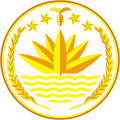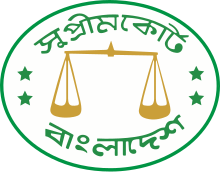| This article is part of a series on the |
| Politics of Bangladesh |
|---|
 |
|
|
|
|
The Judiciary of Bangladesh (Bengali: বাংলাদেশের বিচার বিভাগ — Bānlādēśēra bicāra bibhāga) or Judicial system of Bangladesh (Bengali: বাংলাদেশের বিচার ব্যবস্থা — Bānlādēśēra bicāra byabasthā) is based on the Constitution and the laws are enacted by the legislature and interpreted by the higher courts. Bangladesh Supreme Court is the highest court of Bangladesh. The jurisdiction of the Supreme Court of Bangladesh has been described in Article 94(1) of the Constitution of Bangladesh.[1] It consists of two divisions, the High Court Division and the Appellate Division. These two divisions of the Supreme Court have separate jurisdictions.[2]
 Motto: "বিসমিল্লাহির রাহমানির রাহিম" 'بِسْمِ ٱللَّٰهِ ٱلرَّحْمَٰنِ ٱلرَّحِيمِ "In the name of God, the Most Gracious, the Most Merciful" | |
| Service overview | |
|---|---|
| Formerly known as | Federal Judiciary |
| Founded | 16 December 1971 |
| Country | |
| Training Institute | Judicial Administration Training Institute |
| Controlling authority | Supreme Court High Court |
| Legal personality | Judiciary |
| Duties | Justice Administration Public Interest Litigation Guardian of the Constitution |
| Hierarchy of Courts in Bangladesh | 1. Supreme Court 2. High Court 3. District Court 4. Metropolitan Court |
| Post Designation | Justice Judge Magistrate - Judicial & Executive |
| Cadre strength | 1,360 Judges strength (6 in Supreme Court, 86 for High Court, 1,268 for Lower Court) |
| Selection / Appointment | President of Bangladesh |
| Salary | ৳ 30,935-1,42,000 |
| Associations | Bangladesh Judicial Service Association |
| Head of Judiciary | |
| Chief Justice of Bangladesh | Syed Refaat Ahmed |
The Bangladeshi judiciary faces a severe shortage of judges. As of July 2017, 1,268 judges deal with over 2.7 million cases in lower courts, 86 High Court justices deal with 431,000 cases and 6 Supreme Court justices deal with 13,000 cases.[3]
- ^ "Home : Supreme Court of Bangladesh". www.supremecourt.gov.bd. Archived from the original on 5 June 2016. Retrieved 17 June 2016.
- ^ "Legal system of Bangladesh". Retrieved 17 June 2016.
- ^ Sarkar, Ashutosh (8 July 2017). "Top court faces acute shortage of judges". The Daily Star.



